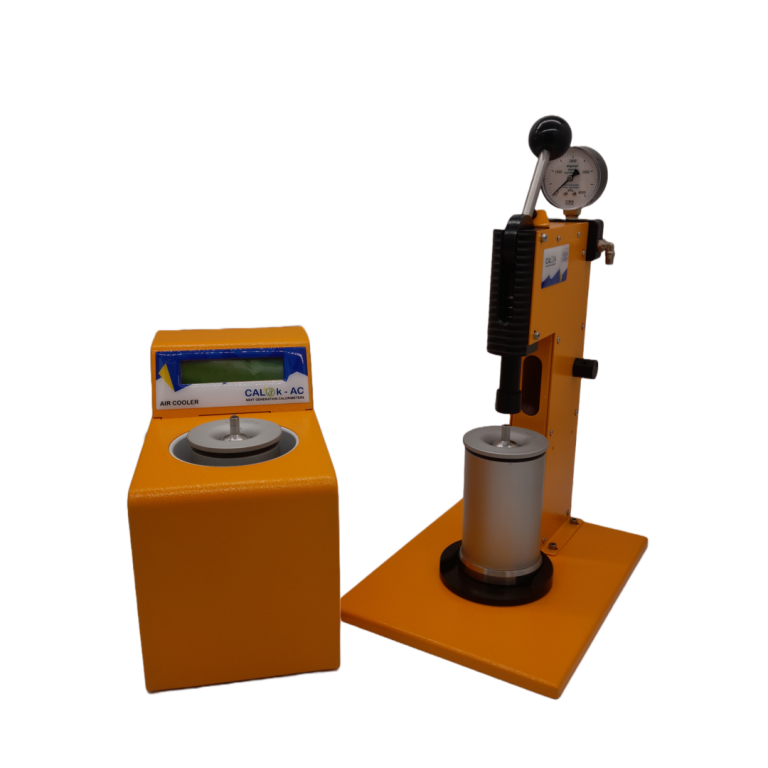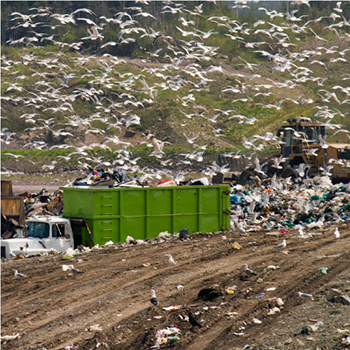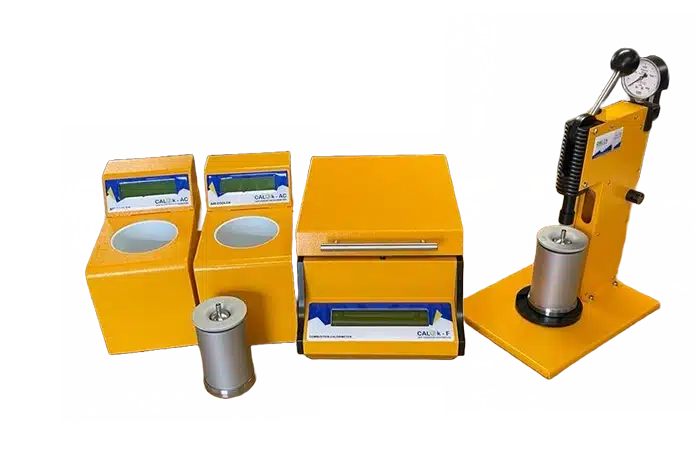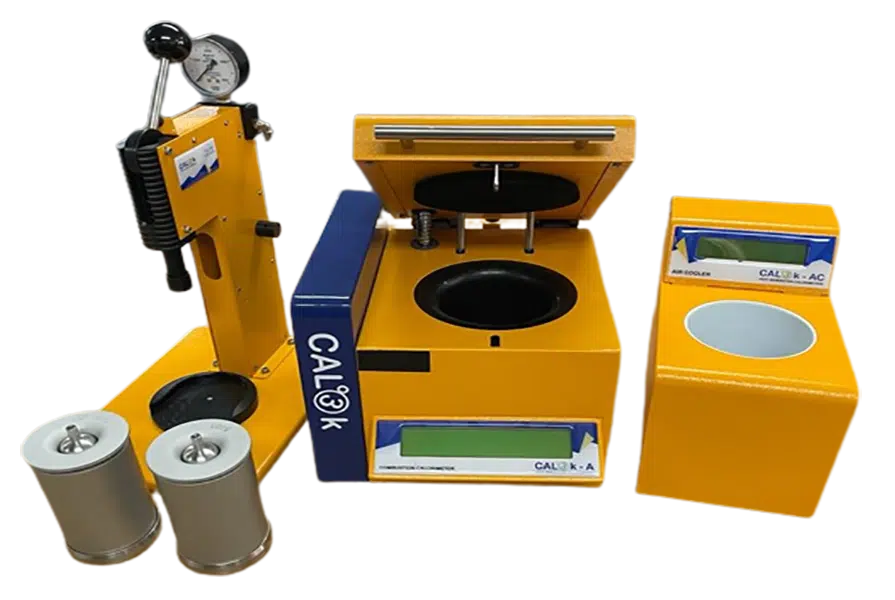CAL4K-4 BOMB VESSEL
The vessel body is stainless steel (on request 316 for halogen) and a pressed on aluminium sleeve which acts as a heat sink and temperature equalizer. This sleeve performs the task of the traditional water and stirrer. The mass of the new 4K-4 vessel was increased by 30% which results in higher energy release of samples.
The 4K-4 vessel can be used in any of the DDS calorimeters and coolers for effective routine sample determination. The speed of a determination depends on the type of calorimeter it is used in, the cooling method, the number of vessels, and other system variables.
Please note that other bomb vessels like the bayonet bomb vessel were supplied with our systems prior to 2023.




CAL4K-4 OXYGEN BOMB VESSELS

The sensors are embedded in the vessel walls. The electronics are located in the bottom of the vessel and are vacuum encapsulated to prevent any liquid or dust from affecting the temperature measurement. The temperature is measured with platinum sensors, which are near linear, and the readings are linearised to become absolute linear. This is a major advantage as the vessel can be fired at any temperature and remains perfectly calibrated. The temperature measuring range is 5 to 70 Celsius. A typical determination rises the vessel temperature by approximately 10C.
The temperature sensors are stable at a working resolution of 0.000001°C or 1 part per million. To put this into some kind of perspective: it is very little. The electronics in the vessel consume a constant of about 0.04Watts, which is automatically corrected for. Because the electronics work at the same temperature as the vessel the overall temperature (rise) accuracy is in the range of 10ppm (0.00001).
What does all this mean in real terms?
The theoretical electronic accuracy related to 26Kj/g is 0.0003Kj/g. Of course, this is not the accuracy you can expect on the final result, which is subject to moisture, sample preparation, sample consistency, weighing and operator procedure, and a lot of other influences. Basically, the CAL4K_4 vessel can be used for extremely accurate results, but is limited by its use.
The vessel tests itself every time it is inserted into the bomb well. The results are reported back to the calorimeter for storage and displaying. The vessel electronics are tested three times in the factory - after assembly, then after 24 hours oven burn-in, and then finally after packaging. All the times are recorded in the vessel memory together with such information as: Customer, Assigned Serial Number.
Vessel testing happens every time it is inserted into the bomb well. The results are stored and reported back to the calorimeter. This is amazing. Each vessel has its own statistics, from o-ring count, firing wire change, misfires, maximum temperatures and the test results.
Another great benefit will be the machine assembled vessel control card (the "brain"). Improved quality and reliability. The vessel electronics are now tested three times in the factory - after assembly, then after 24 hours oven burn-in, and then finally after packaging. All the times are recorded in the vessel memory together with such information as : Manufacturer, Dealer/ Agent , Customer, Assigned Serial Number.
COMPATIBILITY
The CAL3K 4K-4 Thread Type Vessel is compatible with the following oxygen calorimeter systems :
- CAL3K-AP Oxygen Bomb Calorimeter System (Automatic Filling Vessel)
- CAL3K-A Oxygen Bomb Calorimeter System (Manual Filling Vessel)
- CAL3K-U Oxygen Bomb Calorimeter System (Manual Filling Vessel)
- CAL3K-F Oxygen Bomb Calorimeter System (Manual Filling Vessel)
| Feature | Description |
|---|---|
| Reduced Thermal Mass | Thermal mass reduced by approx. 50% gives more resolution and is easier to handle. |
| Screw (Thread) Cap Aluminium Lid | Screw (Thread) Cap aluminium lid for fast opening and closing |
| Improved Resolution | Greatly improved temperature resolution of 1ppm gives improved accuracy. |
| Reduced Interference | Greatly reduces noise interference of <10ppm gives very stable results. |
| Improved Self-Testing | Improved factory, field and self testing |
| Operational History | Vessel operation history available |
| Calibration History | It holds the history of up to 70 calibrations |
| Linear Temperature Sensing | Very linear temperature sensing allows two determination without cooling |
| Improved Parameters | Improved setup parameters and temperature calibration |
| Calibration Fields | 7 Calibration Fields |
| Average Calibrations | Maximum of 10 calibrations per field |
| Temperature Recording | Maximum Temperature Recording |
| Limit Settings | Inspection warning and limit settings |
| Inspection Records | Inspection Records |
| Safety Feature | Vessel will not fill with oxygen if the lid is not properly sealed |

Animal Feed Research
Food calories are measured in KJ/g, the same as combustible calories. However, the process is different, although the outcome is the same : KJ/g or heat, or calories. Animal feed stock relies on the animal digestion (conversion). A calorimeter burns the lot and measures the released heat. Then a calorimeter can't be used to measure feed stock?
View Application
Coal & Coke Analysis
The coal industry is the traditional application of calorimeters because coal has a variety of properties, apart from being black. If the coal is used for steam generation then the calorific value is of paramount importance. The calorific value, short CV, is a measure of how much heat can be extracted from it.
View Application
Explosives Analysis
Only explosives which can be ignited by heat from the calorimeter's firing circuit can be tested in the oxygen calorimeter. Then very minute/small quantities are used for analysis. The calorific value of an explosive is not very high, but the burning speed is.
View Application
Fuel Analysis
As a general rule, volatile fuels are measured very seldom because they are very consistent. However, if the fuel absorbs water, then frequent analysis is called for. Volatile fuel such as alcohol must be prevented from evaporating during the handling process that is from weighing to ignition of the sample.
View Application
Food & Nutrition Analysis
Here is an example of food calories from www.scientificamerican.com. As the article says : "The method of using a combustion calorimeter to measure food calories is not frequently used today. However, after some considerations it can, and is, used today for checking the production quality of food." Let's look at the details.
View Application
Oil Analysis
Oils are a non-volatile substance. In general they are not measured frequently because they are very consistent and uniform. Other oil properties are more important than the calorific value, such as taste or viscosity. If an oil is measured in an oxygen calorimeter, then the procedure would be the same as a solid substance.
View Application
Universities
Simple, we at Digital Data Systems (DDS) have been making calorimeters for the last 40 years. We have a wealth of technical knowledge and calorimeter experience second to none. We are continuously improving our systems with the latest technology as it becomes available, allowing the students to work on a cost effective, easy to use...
View Application
Waste Product Analysis
Heating energy is being dumped on our municipal landfill sites. Our landfill sites are being clogged by plastic waste, which battle to bio-degrade over time. Alternative options for managing plastic waste has been identified as mechanical recycling, cement kilns, power station and energy recovery by incineration. Having plastic on landfill sties should be the last option.
View Application-
A Dry Waterless Bomb Vessel for CAL3K
The Pressurised CAL3K Bomb Vessel requires no water to operate, saving resources and making it eco-friendly
RELATED PRODUCTS
Other DDS Calorimeter Products in the same range

CAL3K-F CALORIMETER
A flexible system for low to high throughput without compromising on accuracy and repeatability. It is used in Food/Feed Analysis, Alternative Energy, Scientific Determinations, Coal and Oil Production, research and Quality Assurance. In short : where the calorific value of a solid/liquid sample must be determined.
View Product
CAL3K-AP CALORIMETER
Our top of the range product is our faster calorimeter in the CAL3K range. The CAL3K-AP has a sample repeat speed of 4-6 minutes per sample and can handle more than 10 samples per hour for faster throughput.
View Product
CAL3K-A CALORIMETER
The CAL3K-A is best suited for a production environment with shared oxygen supply (to other users) and robust handling. One external oxygen filling station can service multiple CAL3K Calorimeter Systems. The DDS Calorimeters range can be used to determine the calorific value of solid and liquid combustibles including oil, coke, volatile fuels, biomass, plastic, coal, animal feeds and food stuffs.
View Product




